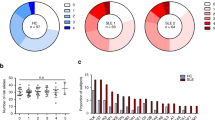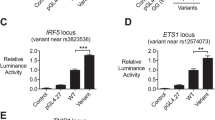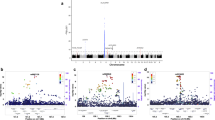Abstract
Systemic lupus erythematosus (SLE) is a prototypical autoimmune disease characterized by production of autoantibodies and complex genetic inheritance1,2,3. In a genome-wide scan using 85,042 SNPs, we identified an association between SLE and a nonsynonymous substitution (rs10516487, R61H) in the B-cell scaffold protein with ankyrin repeats gene, BANK1. We replicated the association in four independent case-control sets (combined P = 3.7 × 10−10; OR = 1.38). We analyzed BANK1 cDNA and found two isoforms, one full-length and the other alternatively spliced and lacking exon 2 (Δ2), encoding a protein without a putative IP3R-binding domain. The transcripts were differentially expressed depending on a branch point–site SNP, rs17266594, in strong linkage disequilibrium (LD) with rs10516487. A third associated variant was found in the ankyrin domain (rs3733197, A383T). Our findings implicate BANK1 as a susceptibility gene for SLE, with variants affecting regulatory sites and key functional domains. The disease-associated variants could contribute to sustained B cell–receptor signaling and B-cell hyperactivity characteristic of this disease.
This is a preview of subscription content, access via your institution
Access options
Subscribe to this journal
Receive 12 print issues and online access
$209.00 per year
only $17.42 per issue
Buy this article
- Purchase on Springer Link
- Instant access to full article PDF
Prices may be subject to local taxes which are calculated during checkout

Similar content being viewed by others
Change history
27 March 2008
In the version of this article initially published, the name of the 15th author was misspelled. The correct author name is Nadia Barizzone. Also, the affiliation of Javier Martin was incomplete. Dr. Martin is affiliated with Instituto de Biomedicina López-Neyra, Grenada 18100, Spain and Consejo Superior de Investigaciones Científicas (CSIC), Grenada 18100 Spain. The errors have been corrected in the HTML and PDF versions of the article.
References
Sherer, Y., Gorstein, A., Fritzler, M.J. & Shoenfeld, Y. Autoantibody explosion in systemic lupus erythematosus: more than 100 different antibodies found in SLE patients. Semin. Arthritis Rheum. 34, 501–537 (2004).
Sestak, A.L., Nath, S.K., Sawalha, A.H. & Harley, J.B. Current status of lupus genetics. Arthritis Res. Ther. 9, 210 (2007).
Alarcon-Riquelme, M.E. The genetics of systemic lupus erythematosus: understanding how SNPs confer disease susceptibility. Springer Semin. Immunopathol. 28, 109–117 (2006).
Forner, K., Guedj, M., Dauvillier, J. & Wojcik, J. Universal false discovery rate estimation methodology for genome-wide association studies. Hum. Hered. 65, 183–194 (2008).
Yokoyama, K. et al. BANK regulates BCR-induced calcium mobilization by promoting tyrosine phosphorylation of IP(3) receptor. EMBO J. 21, 83–92 (2002).
Aiba, Y. et al. BANK negatively regulates Akt activation and subsequent B cell responses. Immunity 24, 259–268 (2006).
Burge, C.B., Tuschl, T. & Sharp, P.A. The RNA World II. (eds. Gesteland, R.F., Cech, T.R. & Atkins, J.F.) 525–560 (Cold Spring Harbor Laboratory Press, Cold Spring Harbor, New York, 1999).
Purcell, S., Daly, M.J. & Sham, P.C. WHAP: haplotype-based association analysis. Bioinformatics 23, 255–256 (2007).
Jordan, M.S., Singer, A.L. & Koretzky, G.A. Adaptors as central mediators of signal transduction in immune cells. Nat. Immunol. 4, 110–116 (2003).
Kurosaki, T. Regulation of B-cell signal transduction by adaptor proteins. Nat. Rev. Immunol. 2, 354–363 (2002).
Okada, T., Maeda, A., Iwamatsu, A., Gotoh, K. & Kurosaki, T. BCAP: the tyrosine kinase substrate that connects B cell receptor to phosphoinositide 3-kinase activation. Immunity 13, 817–827 (2000).
Patterson, R.L., Boehning, D. & Snyder, S.H. Inositol 1,4,5-trisphosphate receptors as signal integrators. Annu. Rev. Biochem. 73, 437–465 (2004).
Li, M. & Pritchard, P.H. Characterization of the effects of mutations in the putative branchpoint sequence of intron 4 on the splicing within the human lecithin:cholesterol acyltransferase gene. J. Biol. Chem. 275, 18079–18084 (2000).
Mohler, P.J. et al. Ankyrin-B mutation causes type 4 long-QT cardiac arrhythmia and sudden cardiac death. Nature 421, 634–639 (2003).
Blom, N., Gammeltoft, S. & Brunak, S. Sequence and structure-based prediction of eukaryotic protein phosphorylation sites. J. Mol. Biol. 294, 1351–1362 (1999).
Anolik, J., Sanz, I. & Looney, R.J. B cell depletion therapy in systemic lupus erythematosus. Curr. Rheumatol. Rep. 5, 350–356 (2003).
Liossis, S.N., Kovacs, B., Dennis, G., Kammer, G.M. & Tsokos, G.C. B cells from patients with systemic lupus erythematosus display abnormal antigen receptor-mediated early signal transduction events. J. Clin. Invest. 98, 2549–2557 (1996).
Huck, S., Le Corre, R., Youinou, P. & Zouali, M. Expression of B cell receptor-associated signaling molecules in human lupus. Autoimmunity 33, 213–224 (2001).
Liossis, S.N. et al. B-cell kinase lyn deficiency in patients with systemic lupus erythematosus. J. Investig. Med. 49, 157–165 (2001).
Hibbs, M.L. et al. Sustained activation of Lyn tyrosine kinase in vivo leads to autoimmunity. J. Exp. Med. 196, 1593–1604 (2002).
Flores-Borja, F., Kabouridis, P.S., Jury, E.C., Isenberg, D.A. & Mageed, R.A. Decreased Lyn expression and translocation to lipid raft signaling domains in B lymphocytes from patients with systemic lupus erythematosus. Arthritis Rheum. 52, 3955–3965 (2005).
Cornall, R.J. et al. Polygenic autoimmune traits: Lyn, CD22, and SHP-1 are limiting elements of a biochemical pathway regulating BCR signaling and selection. Immunity 8, 497–508 (1998).
Kozyrev, S.V. et al. Structural insertion/deletion variation in IRF5 is associated with a risk haplotype and defines the precise isoforms expressed in SLE. Arthritis Rheum. 56, 1234–1241 (2007).
Tan, E.M. et al. The 1982 revised criteria for the classification of systemic lupus erythematosus. Arthritis Rheum. 25, 1271–1277 (1982).
Guedj, M., Wojcik, J., Della-Chiesa, E., Nuel, G. & Forner, K. A fast, unbiased and exact allelic test for case-control association studies. Hum. Hered. 61, 210–221 (2006).
Stephens, M. & Donnelly, P. A comparison of bayesian methods for haplotype reconstruction from population genotype data. Am. J. Hum. Genet. 73, 1162–1169 (2003).
Stephens, M., Smith, N.J. & Donnelly, P. A new statistical method for haplotype reconstruction from population data. Am. J. Hum. Genet. 68, 978–989 (2001).
Dudbridge, F. Pedigree disequilibrium tests for multilocus haplotypes. Genet. Epidemiol. 25, 115–121 (2003).
Acknowledgements
The authors would like to express their gratitude to S. Lewén for help with purification of PBMCs and total RNA, H. Yin for help with the preparation of DNA samples and to the members of the Uppsala Genome Center for help with sequencing. We thank T. Bergström and L. Cavelier (Uppsala University) for providing RNA from chimpanzee spleen. We also thank A.I. Scollo, A.M. Perichon and M.C.R. Tenaglia (CEDIM, Diagnóstico Molecular y Forense SRL, Rosario, Argentina) for their help in DNA preparation of the Argentine samples and A. Voss for clinical help with the Danish samples. The authors would like to thank particularly the Lupus Patient Association of Asturias for their help in the collection of samples as well as all the patients for their contribution. The authors would also like to thank J.Osorio y Fortea (Pasteur Institut, Paris) for his contribution in the analyses that led to the identification of R61H early in this project.
This work has been supported in part by grants from the European CVDIMMUNE project from the European Commission LSHM-CT-2006-037227, Swedish Research Council for Medicine (12703), the Swedish Association against Rheumatism, the Magnus Bergwalls Foundation, the Gustaf V: 80th-year Jubilee Foundation, the Torsten and Ragnar Söderbergs Foundation and the Marcus Borsgtröms Foundation to M.E.A.-R. and by the Gurli and Edward Brunnbergs Foundation for rheumatologic research to S.V.K. M.E.A.-R. is supported by an award from the Knut and Alice Wallenberg Foundation through the Royal Swedish Academy of Sciences. This work was also partially supported by FISM, Regione Piemonte (CIPE), the Bundesministerium für Bildung und Forschung (BMBF) Kompetenznetz Rheuma C2.12, Germany and the Danish Rheumatism Association.
Author information
Authors and Affiliations
Contributions
M.E.A.-R., S.V.K. and H.A. designed the experiments. S.V.K., A.-K.A., J.W., A.Z., M.V.P.L.R. and E.S. performed the experiments. M.E.A.-R., S.V.K., A.-K.A., J.W. and H.A. performed the analyses. I.G., E.S., G.S., L.T., A.J., T.W., S.D., N.B., M.G.D., C.G., A.S., P.J., H.L., B.A.P.-E., M.F.G.-E. and J.M. and their multicenter collaborators provided the samples. M.E.A.-R., S.V.K. and A.-K.A. wrote the manuscript.
The Argentine Collaborative Group participants are:
Hugo R. Scherbarth, Pilar C. Marino and Estela L. Motta (Servicio de Reumatología, Hospital Interzonal General de Agudos 'Dr. Oscar Alende', Mar del Plata, Argentina), Susana Gamron, Cristina Drenkard and Emilia Menso (Servicio de Reumatología de la UHMI 1, Hospital Nacional de Clínicas, Universidad Nacional de Córdoba, Córdoba, Argentina), Alberto Allievi and Guillermo A. Tate (Organización Médica de Investigación, Buenos Aires, Argentina), Jose L. Presas (Hospital General de Agudos Dr. Juán A. Fernandez, Buenos Aires, Argentina), Simon A. Palatnik, Marcelo Abdala and Mariela Bearzotti (Facultad de Ciencias Medicas, Universidad Nacional de Rosario y Hospital Provincial del Centenario, Rosario, Argentina), Alejandro Alvarellos, Francisco Caeiro and Ana Bertoli (Servicio de Reumatología, Hospital Privado, Centro Medico de Córdoba, Córdoba, Argentina), Sergio Paira and Susana Roverano (Hospital José M. Cullen, Santa Fe, Argentina), Cesar E. Graf and Estela Bertero (Hospital San Martín, Paraná, Argentina), Cesar Caprarulo and Griselda Buchanan (Hospital Felipe Heras, Concordia, Entre Ríos, Argentina), Carolina Guillerón, Sebastian Grimaudo and Jorge Manni (Departamento de Inmunología, Instituto de Investigaciones Médicas 'Alfredo Lanari', Buenos Aires, Argentina), Luis J. Catoggio, Enrique R. Soriano and Carlos D. Santos (Sección Reumatología, Servicio de Clínica Medica, Hospital Italiano de Buenos Aires y Fundación Dr. Pedro M. Catoggio para el Progreso de la Reumatología, Buenos Aires, Argentina), Cristina Prigione, Fernando A. Ramos and Sandra M. Navarro (Servicio de Reumatología, Hospital Provincial de Rosario, Rosario, Argentina), Guillermo A. Berbotto, Marisa Jorfen and Elisa J. Romero (Servicio de Reumatología Hospital Escuela Eva Perón, Granadero Baigorria, Rosario, Argentina), Mercedes A. Garcia, Juan C. Marcos and Ana I. Marcos (Servicio de Reumatología, Hospital Interzonal General de Agudos General San Martín, La Plata, Buenos Aires, Argentina), Carlos E. Perandones and Alicia Eimon (Centro de Educación Médica e Investigaciones Clínicas (CEMIC), Buenos Aires, Argentina), and Cristina G. Battagliotti (Hospital de Niños Dr. Orlando Alassia, Santa Fe, Argentina). B.A.P.-E. is coordinator of the Argentine Collaborative Group.
The German Collaborative Group participants are:
K. Armadi-Simab and Wolfgang L. Gross (Abteilung Rheumatologie, University Hospital of Schleswig-Holstein, Campus Luebeck, Rheumaklinik Bad Bramstedt, Luebeck, Germany), Erika Gromnica-Ihle (Rheumaklinik Berlin-Buch, Berlin, Germany), Hans-Hartmut Peter (Medizinische Universitaetsklinik, Abteilung Rheumatologie und Klinische Immunologie, Freiburg, Germany), Karin Manger (Medizinische Klinik III derFAU Erlangen-Nuernberg, Erlangen, Germany), Sebastian Schnarr and Henning Zeidler (Abteilung Rheumatologie, Medizinische Hochschule Hannover, Hannover, Germany) and Reinhold E. Schmidt (Abteilung Klinische Immunologie, Medizinische Hochschule Hannover, Hannover, Germany).
The Spanish Collaborative Group participants are:
Norberto Ortego (Servicio Medicina Interna, Hospital Clínico San Cecilio, Granada, Spain), Enrique de Ramón (Servicio de Medicina Interna, Hospital Carlos Haya, Malaga, Spain), Juan Jiménez-Alonso (Servicio de Medicina Interna, Hospital Virgen de las Nieves, Granada, Spain), Julio Sánchez-Román (Servico de Medicina Interna, Hospital Virgen del Rocio, Sevilla, Spain) and Miguel Angel López-Nevot (Servicio de Inmunología, Hospital Virgen de las Nieves, Granada, Spain).
The Italian Collaborative participants are:
Gian Domenico Sebastiani (U.O.C. di Reumatologia Ospedale San Camillo, Roma, Italy), Enrica Bozzolo (IRCCS San Raffaele Hospital, Milan, Italy), Mauro Galeazzi (Siena University, Siena, Italy), Sergio Migliaresi (Rheumatology Unit Second University of Naples, Naples, Italy). Also we would like to thank Armando Gabrielli, Clinica Medica di Scienze Mediche e Chirurgiche, Universitá Politecnica delle Marche.
Corresponding author
Ethics declarations
Competing interests
Jerome Wojcik and Hadi Abderrahim are employees of Merck Serono Inc. Merck Serono Inc. performed and financed the 100K Affymetrix microarray SNP genotyping.
Supplementary information
Supplementary Text and Figures
Supplementary Tables 1–3, Supplementary Figures 1–3 (PDF 2057 kb)
Rights and permissions
About this article
Cite this article
Kozyrev, S., Abelson, AK., Wojcik, J. et al. Functional variants in the B-cell gene BANK1 are associated with systemic lupus erythematosus. Nat Genet 40, 211–216 (2008). https://doi.org/10.1038/ng.79
Received:
Accepted:
Published:
Issue Date:
DOI: https://doi.org/10.1038/ng.79
This article is cited by
-
Kernel-based genetic association analysis for microbiome phenotypes identifies host genetic drivers of beta-diversity
Microbiome (2023)
-
Genetics of SLE: mechanistic insights from monogenic disease and disease-associated variants
Nature Reviews Nephrology (2023)
-
Predictors of response of rituximab in rheumatoid arthritis by weighted gene co-expression network analysis
Clinical Rheumatology (2023)
-
Recent advances in understanding the genetic basis of systemic lupus erythematosus
Seminars in Immunopathology (2022)
-
Variants in BANK1 are associated with lupus nephritis of European ancestry
Genes & Immunity (2021)



